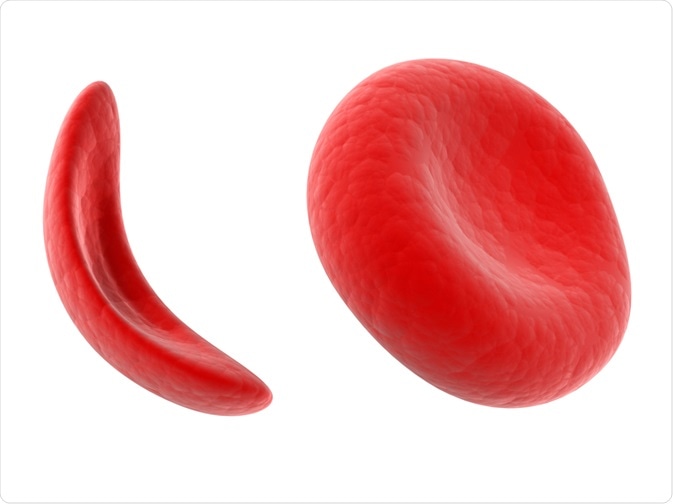Sickle cell trait is where a person carries a single mutated hemoglobin A beta subunit allele. Usually, two mutated copies of this gene are needed to cause sickle cell disease (SCD). Typically, people with SCT do not suffer from any symptoms in life, except in limited circumstances where there may be complications.

Sickle Cell. Image Credit: SciePro/Shutterstock.com
Sickle-Cell Disease (SCD)
Sickle cell disease (SCD) is a group of inherited blood disorders with the commonest type being sickle cell anemia (SCA) which leads to deformed sickle-shaped red blood cells and reduced oxygen-carrying capabilities under certain circumstances and conditions. SCA is caused by 2 genetically inherited (autosomal recessive) mutated versions of the hemoglobin A (HbA) subunit beta-globin (HBB) gene found on chromosome 11p15.5.
SCA is caused by a single nucleotide polymorphism (SNP) where a GAG codon is changed to a GTG codon (single base change A>T (rs334 mutation)) within the beta-globin subunit leading to glutamate (E) being swapped with a valine (V) at position 6 (E6V) – this version is denoted as HbS compared to the normal HbA version.
Typically, this does not lead to any major structural or functional changes to hemoglobin under normal oxygen conditions. However, under certain low oxygenation conditions (i.e., high altitude, strenuous exercise, or dehydration), HbS in red blood cells become deformed (sickled) and cause “vaso-occlusive crises” which may, in turn, lead to organ and tissue damage due to repeated ischemia as well as severe pain.
Sickle Cell Trait (SCT)
SCD/SCA is only caused by 2 mutated copies of the HBB gene (from both parents). Having only one mutated allele – being a carrier – is called sickle cell trait (SCT). A person with SCT can pass this allele on to their offspring, however, if both parents are carriers, then there is a 1 in 4 (25%) chance the child will develop SCA due to the disease being inherited in an autosomal recessive manner.
SCT is usually benign and does not result in SCD or any other issues with health as one functional allele is able to produce normal hemoglobin. However, there may be certain circumstances (usually low oxygen environments, dehydration, and increased acidity) where people with SCT may suffer from medical complications.
For example, 34% (or higher) levels of HbS can lead to papillary necrosis (kidney microthrombi and infarction caused by sickling cells) and thus haematuria (blood in urine). The risk of this is substantially reduced if HbS levels are only around 20%. Therefore, getting a full diagnostic test to assess the hematocrit and levels of HbS is important in guiding one’s lifestyle and choices.
Interestingly, people with SCT are usually protected from severe malaria over people with normal hemoglobin in geographic areas where malaria is endemic. Thus, this has led to an increased prevalence of people with SCT across malaria-common geographic areas (such as Africa and Central America, and those with such ancestry) with a survival advantage due to natural selection. People with SCA are not however at a protective advantage.
The reason why people with SCT are protected from malaria is due to the fact that the malaria-causing parasite Plasmodium falciparum is prevented from infecting and replicating within sickle hemoglobin (HbS) red blood cells reducing the overall number of malaria parasites in the blood. HbS red blood cells also have a higher level heme oxygenase-1 (HO-1) enzyme which produces carbon monoxide protecting against malaria.
Another special consideration concerning SCT is athletes. Firstly, due to the presence of some sickle cells (HbS), SCT athletes may not achieve the same level of performance and endurance compared to non-SCT athletes. However, the biggest and most worrying aspect is that in intense and strenuous exercise (high degree of physical exertion), anaerobic conditions and dehydration can develop which are the main trigger for sickle cells to form – even in SCT individuals.
Depending on the levels of HbS, sickling, and anaerobic/hypoxic conditions that develop, the consequences can vary from microcirculatory disorders and cramps within muscle tissue (rhabdomyolysis) to sudden death in some cases.
In summary, sickle cell trait (SCT) is where individuals carry one mutated allele of the HBB gene (beta globulin subunit of hemoglobin A) with one single nucleotide mutation: E6V, which when inherited in an autosomal recessive manner causes sickle cell disease (SCD). SCT individuals do not have SCD, however, if have children with another carrier of SCT, then there is a 1 in 4 chance that the child will have SCD.
SCT carriers typically do not have any symptoms of disease in life, however, under specific and limited circumstances may develop some complications (such as athletes). Finally, SCT carriers are usually protected against malaria infection and due to natural selection, there is a high prevalence of SCT in malaria-endemic regions such as Africa and Central America.
References:
Further Reading
Last Updated: Jun 18, 2021